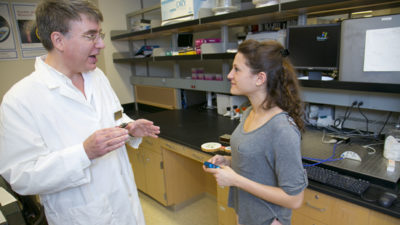UMKC researchers invent non-invasive insulin delivery, offering hope for those with diabetes
University of Missouri-Kansas City senior Amy Johnson, who has type 1 diabetes, has already benefitted from research. But if an invention from the UMKC School of Pharmacy can make the leap from lab to real life, Johnson will benefit even more.
The 21 year old is currently tethered to the latest-greatest insulin-delivery system: a pager-sized pump connected through a tube in the abdomen.
“It beats the alternative of eight injections a day, which is definitely not my cup of tea,” says Johnson, a UMKC Trustees’ Scholar and a biology major. “But the pump has its drawbacks. I still have to change my pump infusion site every other day and I hit a nerve sometimes, which is painful. Sometimes I get the tubing caught on a doorknob. I’ve had to have one overnighted to me because it broke after I bumped into a door handle.”
So Johnson is intrigued by a novel insulin-delivery method that UMKC researchers are developing in the School of Pharmacy. The breakthrough could affect tens of millions of people with type 1 and 2 diabetes by replacing needle sticks with a beam of light.
“We’re aiming to improve the lives of diabetics all over the world,” said UMKC pharmacy professor Simon Friedman who with his collaborators has developed a new method called a photoactivated depot or PAD.
Johnson wishes the PAD insulin-delivery system was available. Now. But it is years away from entering the marketplace.
The PAD would benefit the lives of local residents. In 2009 in Jackson County, there were 48,084 people living with diabetes, or nearly one of 10 people in the population.
Here’s how the PAD works: Insulin is linked to an insoluble polymer by a connection that can be broken with light. The depot can be injected just under the patient’s skin. Insulin can then be released from the polymer by light irradiation through the skin, and then absorbed into the body. Since one injected depot can contain a large amount of insulin, the PAD has the potential to eliminate hundreds of injections. In addition, because light can be administered at any time interval, the release of insulin could be more finely controlled.
It would eliminate an insulin pump, like the one Johnson wears, and it would be replaced with an armband with a device the size of a tiny mp3 player. All insulin pumps use a tube that connects the outside reservoir of insulin to the inside of the patient. This introduces many problems, including clogging of the tube, leading to poor outcomes. The photoactivated depot eliminates this physical connection to the outside world, allowing the insulin to be released non-invasively with a beam of light.
Friedman and his student co-authors, Piyush Jain and Dipu Karunakaran, successfully made the first generation of PADs. The results were published last December in Angewandte Chemie, the highest ranked weekly chemistry journal in the world. The journal’s reviewer called the research “a paradigm shift” and “truly innovative.” This research has the potential to directly impact the health outcomes of tens of millions of individuals with type 1 and type 2 diabetes worldwide.
In people with type 1 diabetes like Johnson, the pancreas no longer makes insulin. The beta cells have been destroyed and they need insulin shots to use glucose from meals.
People with type 2 diabetes make insulin, but their bodies don’t respond well to it. At first, the pancreas produces extra insulin to make up for it. But over time it isn’t able to keep up and can’t make enough insulin to keep blood glucose at normal levels.
About 25.6 million children and adults in the U.S. — 8.3 percent of the population — have diabetes, according to the American Diabetes Association. More than 25 percent use insulin shots. About 79 million people in the U.S. have prediabetes.
Complications from diabetes include heart disease and stroke, high blood pressure, blindness, kidney disease, nervous system damage and amputation.

